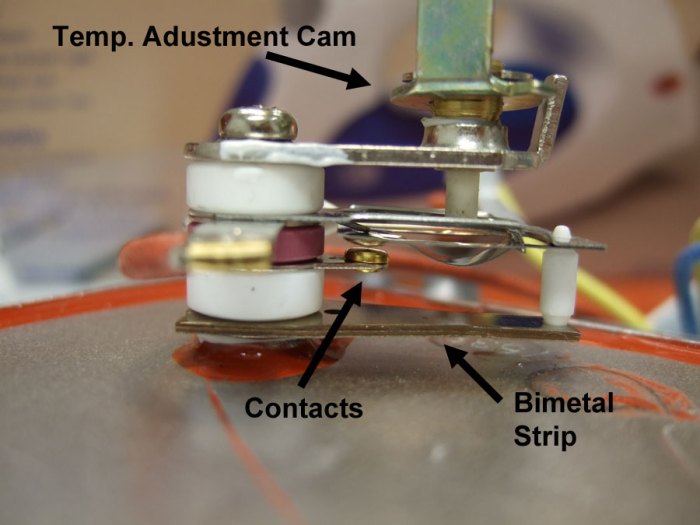Bimetal line voltage thermostats are commonly used in various applications due to their reliability, accuracy, and cost-effectiveness. These devices utilize the principle of differential thermal expansion to regulate temperature by switching electrical circuits on and off. In this article, we will explore the types, advantages, applications, and design considerations of bimetal line voltage thermostats, providing a comprehensive overview of their role in temperature control systems.
Types of Bimetal Line Voltage Thermostats
Bimetal line voltage thermostats come in various types, each with its unique characteristics and applications. Here are the most common types:
Snap-acting Thermostats
- Operate with a sudden, rapid action when the temperature reaches a set point.
- Suitable for applications requiring precise temperature control and fast response times.
Proportional Thermostats, Bimetal line voltage thermostats are commonly used
- Gradually adjust the output based on the temperature deviation from the set point.
- Provide smoother temperature control and reduce temperature fluctuations.
Two-step Thermostats
- Have two distinct temperature set points and provide two levels of heating or cooling.
- Used in applications where different temperature ranges are desired at different times of the day.
Three-step Thermostats
- Similar to two-step thermostats but provide three distinct temperature set points and three levels of heating or cooling.
- Offer greater flexibility and customization for temperature control.
Advantages of Bimetal Line Voltage Thermostats

Bimetal line voltage thermostats offer several advantages over other types of thermostats:
- Reliability:Simple design with few moving parts, resulting in high reliability and long service life.
- Cost-effectiveness:Relatively inexpensive to manufacture and maintain compared to other thermostat types.
- Compact size:Can be easily installed in tight spaces or where space is limited.
- Durability:Robust construction withstands harsh environments and temperature fluctuations.
- Versatility:Available in various types and configurations to meet specific application requirements.
Applications of Bimetal Line Voltage Thermostats

Bimetal line voltage thermostats are widely used in various applications, including:
- HVAC systems:Controlling temperature in heating, ventilation, and air conditioning systems for residential, commercial, and industrial buildings.
- Industrial machinery:Monitoring and regulating temperature in ovens, furnaces, and other industrial processes.
- Refrigeration systems:Maintaining desired temperatures in refrigerators, freezers, and cold storage units.
- Medical equipment:Ensuring accurate temperature control in incubators, sterilizers, and other medical devices.
- Home appliances:Regulating temperature in ovens, stoves, and water heaters.
Installation and Maintenance of Bimetal Line Voltage Thermostats

Proper installation and maintenance are crucial for the optimal performance of bimetal line voltage thermostats:
Installation
- Follow the manufacturer’s instructions carefully.
- Ensure the thermostat is installed in a location with good airflow and away from heat sources.
- Connect the thermostat to the appropriate electrical supply.
Maintenance
- Regularly inspect the thermostat for any damage or loose connections.
- Clean the thermostat using a soft cloth and mild detergent.
- Calibrate the thermostat periodically to ensure accurate temperature readings.
Troubleshooting Bimetal Line Voltage Thermostats

If a bimetal line voltage thermostat is not functioning correctly, the following troubleshooting steps can be taken:
- Check the power supply:Ensure the thermostat is receiving power.
- Inspect the wiring:Look for any loose or damaged wires.
- Test the thermostat:Use a multimeter to check the continuity of the bimetal element.
- Clean the thermostat:Dirt or debris may interfere with the thermostat’s operation.
- Replace the thermostat:If the troubleshooting steps do not resolve the issue, the thermostat may need to be replaced.
FAQ Summary: Bimetal Line Voltage Thermostats Are Commonly Used
What are the different types of bimetal line voltage thermostats?
Bimetal line voltage thermostats come in various types, including snap-acting, gradual-acting, and adjustable models. Snap-acting thermostats switch circuits on and off abruptly, while gradual-acting thermostats provide a more gradual temperature change. Adjustable thermostats allow for precise temperature setting.
What are the advantages of using bimetal line voltage thermostats?
Bimetal line voltage thermostats offer several advantages, including reliability, accuracy, cost-effectiveness, and ease of installation. They are also durable and require minimal maintenance.
Where are bimetal line voltage thermostats commonly used?
Bimetal line voltage thermostats are commonly used in residential and commercial settings, including heating and cooling systems, industrial equipment, and appliances. They are also found in temperature-sensitive applications such as food storage and medical equipment.